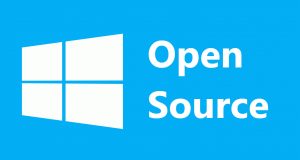Microsoft Windows Goes Open Source!
Would you imagine this kind of headline could appear one day in the media? You say “impossible”? I say “why not?”. In the end, Microsoft is known as one of the biggest open source contributors.

Lately, I was spending quite some time digging some info about Microsoft and I was very impressed to discover that the corporation strongly committed itself to the open source movement.
1) The Good Bad Old Days
Back in the days Microsoft and Bill Gates were, probably, the most fierce open source haters. Of course, the OSS community loved them back with the slogans like “Windows Must Die”. But the things have changed since then.

Here is an interesting quote from the article “Who really contributes to open source”, which describes pretty well the mind shift of the company: “For those of us that were around when Microsoft castigated open source as a “cancer” and “anti-American,” this is a remarkable change of heart (or, as I’ve argued, a change of business model).”
2) Contributors vs. Products
What’s the right way to measure the level of contribution of a company to the open source community? Microsoft is very proud of being the no. 1 company by the number of engineers involved in different open source projects. Google is the no. 2 after Microsoft with quite a big gap. But is it the best metric to measure the impact of a company? I don’t think so.
A better way to measure the impact is, in my opinion, by counting the amount of highly popular open source projects initiated and maintained by the company. There are four projects attributed to Microsoft, which I would call popular: Visual Studio Code, TypeScript, .NET Core and PowerShell. Let’s count Google’s popular projects: Android, Angular, Chromium, Go, Kubernetes, Polymer and TensorFlow. Google clearly wins here.
Now, imagine how close to Google Microsoft will come by releasing the products like Windows, Internet Explorer, Skype and Office under an open source license…
3) Your Choice
Does Microsoft have much choice? Not really… if you consider that one of their main rivals in the OS business Apple has released the core of their operating system Darwin years ago under an open source license. Another rival, Google, launched Android from the very beginning as an open source product.
Will this move cannibalize Microsoft’s income streams from the OS business? Very unlikely! As their main Windows income is from enterprise customers and businesses, they can keep charging commercial usage of Windows and make it free for private usage and non-profits.
4) New Opportunities
By moving into the open source business model Microsoft will be forced to be more creative about the ways how to make money. Today’s world is moving more from products to the services. Products are playing more the role of platforms and the services are the ones that add value and bring the main income to the company.
5) Better Quality
Popular open source projects are known to be of very high quality. The main reasons behind it include the “many eyeballs” effect and the diversity of the developers. This effect is well described in the Linus’s Law. The law states that “given enough eyeballs, all bugs are shallow”; or more formally: “Given a large enough beta-tester and co-developer base, almost every problem will be characterized quickly and the fix obvious to someone.”
6) Win-Win
This move would be a clear win-win for everyone. Microsoft will show its commitment to the open source community like no other. The company will discover new service-based revenue streams. It will be able to identify and hire the best open source Windows contributors. The quality of Windows will increase dramatically because of the “many eyeballs” effect. Maybe this move will also contribute to the return of Microsoft into the smartphone business and become the 3rd major player along with Android and iOS.
7) Conclusion
The future is open. Whether you embrace it or not only shows how visionary or short-sighted you are. Microsoft is already on a good way.